The Intel Core i5-7600K (91W) Review: The More Amenable Mainstream Performer
by Ian Cutress on January 3, 2017 12:01 PM ESTLegacy and Synthetic Tests
At AnandTech, I’ve taken somewhat of a dim view to pure synthetic tests, as they fail to be relatable. Nonetheless, our benchmark database spans to a time when that is all we had! We take a few of these tests for a pin with the latest hardware.
Cinebench R10
The R10 version of Cinebench is one of our oldest benchmarks, with data going back more than a few generations. The benchmark is similar to that of the newest R15 version, albeit with a simpler render target and a different strategy for multithreading.
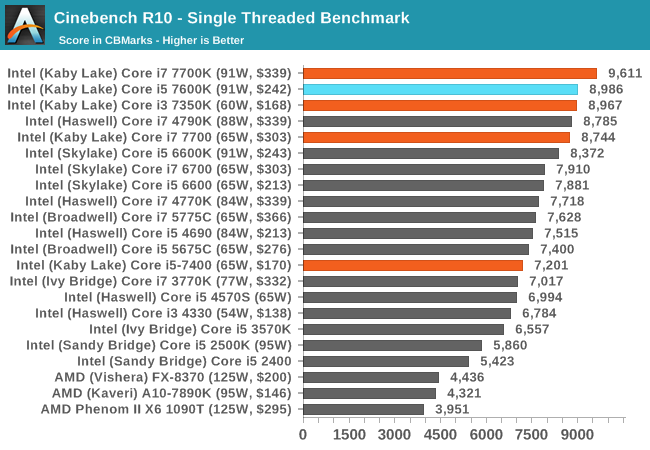
With high frequency in tow, the Core i5-7600K matches that of the previous generation i7-6700K, and goes above the Devil’s Canyon i7 as well.
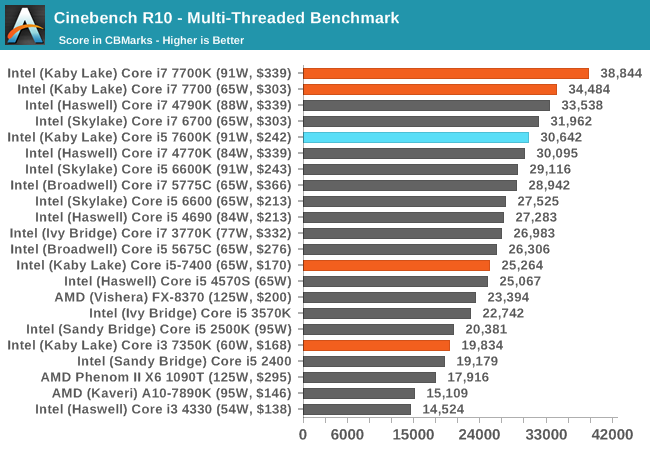
When more threads come to play, the Core i5-7600K sits atop all the other i5 parts, and because hyperthreads have little effect here, the combination of IPC and frequency pushes the Core i5-7600K above previous top performers such as the Core i7-4770K.
Cinebench R11.5
CB11.5 has been popular for many years as a performance test, using easy to read and compare numbers that aren’t in the 1000s. We run the benchmark in an automated fashion three times in single-thread and multi-thread mode and take the average of the results.
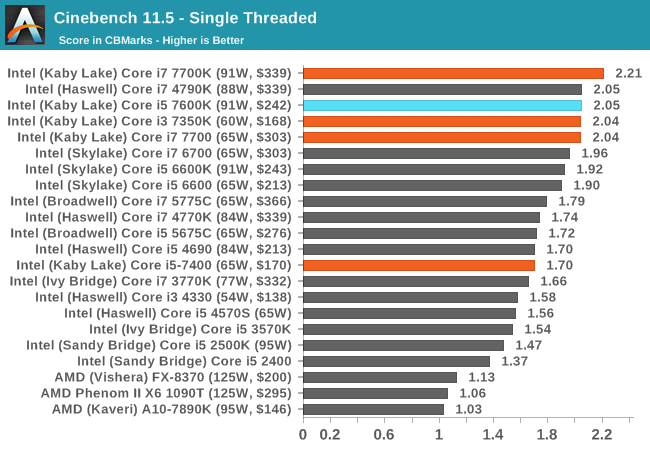
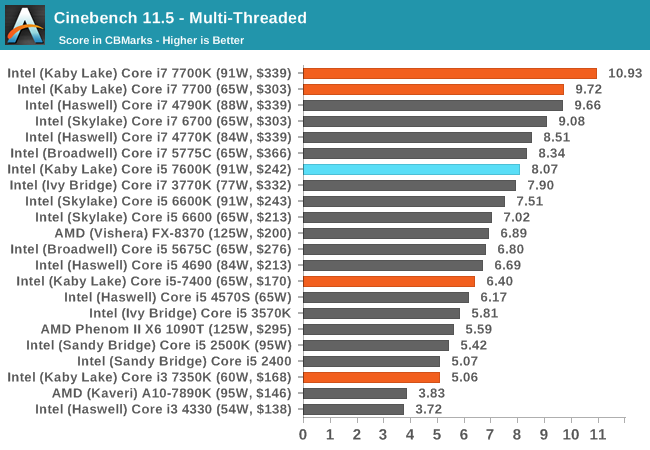
Out of the box the i5-7600K hits above a 2.00 on the single threaded test and above 8.00 on the multithreaded test, showing that the scaling with cores on CB11.5 is very reasonable.
7-zip
As an open source compression/decompression tool, 7-zip is easy to test and features a built-in benchmark to measure performance. As a utility, similar to WinRAR, high thread counts, frequency and UPC typically win the day here.
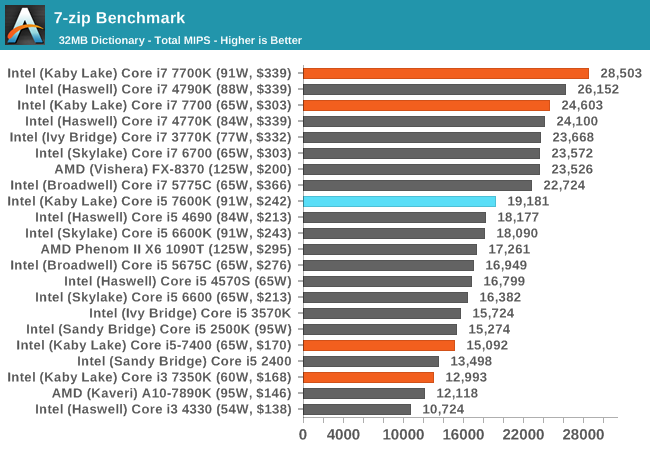
The Core i7-7700K shows the benefits of frequency over a stock i7-6700K, however at the same frequency they perform roughly the same as expected.
POV-Ray
Ray-tracing is a typical multithreaded test, with each ray being a potential thread in its own right ensuring that a workload can scale in complexity easily. This lends itself to cores, frequency and IPC: the more, the better.
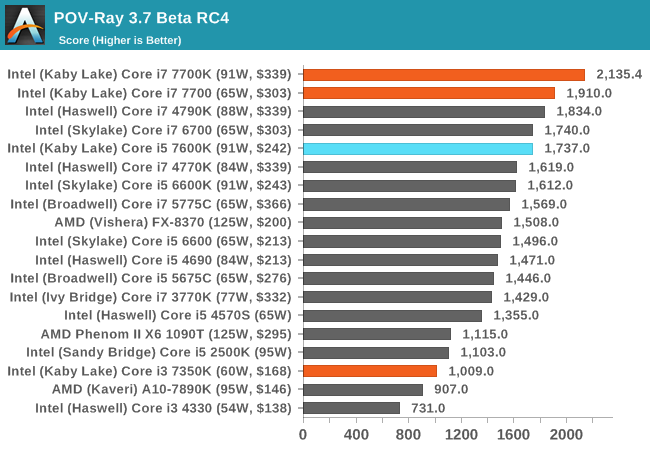
AES via TrueCrypt
Despite TrueCrypt no longer being maintained, the final version incorporates a good test to measure different encryption methodologies as well as encryption combinations. When TrueCrypt was in full swing, the introduction of AES accelerated hardware dialed the performance up a notch, however most of the processors (save the Pentiums/Celerons) now support this and get good speed. The built-in TrueCrypt test does a mass encryption on in-memory data, giving results in GB/s.
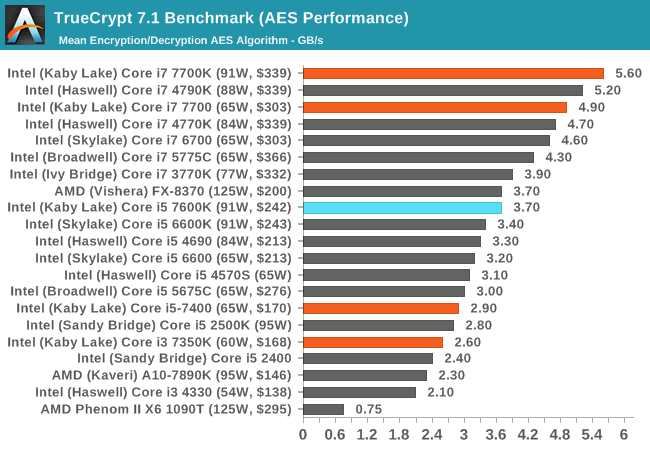










70 Comments
View All Comments
Magichands8 - Tuesday, January 3, 2017 - link
This Optane looks completely useless. But Optane DRAM sounds like it could be interesting. Depending upon how much slower it is.lopri - Wednesday, January 4, 2017 - link
I immediately thought of "AMD Memory" which AMD launched after the Bulldozer flop. But then again Intel have been going after this storage caching scheme for years now and I do not think it has taken them anywhere.smilingcrow - Tuesday, January 3, 2017 - link
Games frame rates to 2 decimal points adds nothing but making it harder to scan the numbers quickly. Enough already.1_rick - Tuesday, January 3, 2017 - link
One place where the extra threads of an i7 are useful is if you're using VMs (maybe to run a database server or something.) I've found that an i5 with 8GB can get bogged down pretty drastically just from running a VM.Meteor2 - Tuesday, January 3, 2017 - link
I kinda think that if you're running db VMs on an i7, you're doing it wrong.t.s - Wednesday, January 4, 2017 - link
or if you're Android developer using Android Studio.lopri - Wednesday, January 4, 2017 - link
That is true but as others have implied you can get 6 or 8 real core Xeons for cheaper than these new Kaby Lake chips if VM is what you need the performance of a CPU is for.ddhelmet - Tuesday, January 3, 2017 - link
Well I am more glad now that I got a Skylake. Even if I waited for this the performance increase is not worth it.Kaihekoa - Tuesday, January 3, 2017 - link
Y'all need to revise your game benchmarking analysis. At least use some current generation GPUs, post the minimum framerates, and test at 1440p. The rest of your review is exceptional, but the gaming part needs some modernization, please.lopri - Wednesday, January 4, 2017 - link
I thank the author for a clear yet thorough review. A lot of grounds are covered and the big picture of the chip's performance and features is well communicated. I agree with the author's recommendation at the end as well. I have not felt that I am missing out anything compared to i7's while running a 2500K for my gaming system, and unless you know for certain that you can take advantage of HyperThreading, spending the difference in dollars toward an SSD or a graphics card is a wiser expenditure that will provide you with better computing experience.Having said that, I am wtill not compelled to upgrade my 2500K which has been running at 4.8 GHz for years. (It does 5.0 GHz no problem but I run it at 4.8 to leave some "headroom") While I think the 7600K is barely a worthy upgrade (finally!) on its own light, but the added cost cannot be overlooked. A new motherboard, new memory, and potentially a new heat sink will quickly add to the budget, and I am not sure if it is going to be worth all the expenses that will follow.
Of course all that could be worthwhile if overclocking was fun, but Intel pretty much have killed overclocking and the overclocking community. Intentionally if I might add. Today overclocking does not give one a sense of discovery or accomplishment. Competition between friendly enthusiasts or hostile motherboard/memory vendors has disappeared. Naturally there is no accumulation or exchange of knowledge in the community, and conversations have become frustrating and vain due to lack of overclocking expertise. Only some brute force overclocking with dedicated cooling has some following, and the occasional "overclocking" topics in the forums are really a braggadocio in disguise, of which the competition underneath is really about who spent the most on their rigs with the latest blingy stuff. Needless to say those are not as exciting or illuminating as the real overclocking of the yore, and in my opinion there are better ways to spend money for such a self-gratification without the complication that often accompanies overclocking which in the end fails to impress.
Intel might have a second thought about its overclocking policies now, but just as many things Intel have done in recent years, it is too little too late. And their chips have no headroom anyway. My work system is due for an upgrade and I am probably going to pick up a couple of E2670s which will give me 16 real cores for less than $200. Why bother with the new stuff when the IPC gain is meager and there is no fun in overclocking? And contribute to Intel's revenue? Thank you but no thank you.
P.S. Sorry I meant to commend the author for the excellent (albeit redundant) review but ended up ranting about something else. Oh well, carry on..